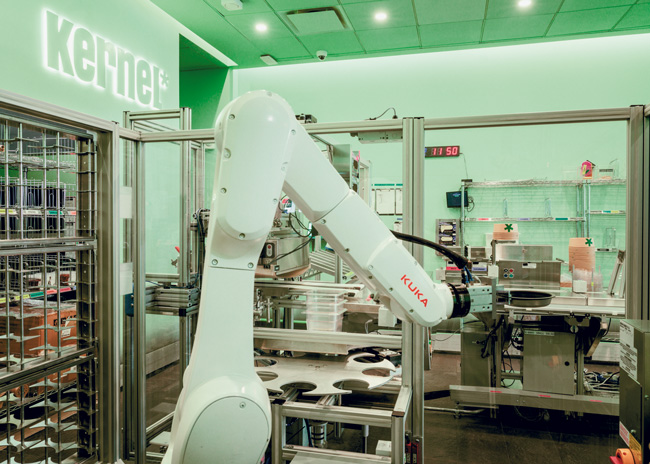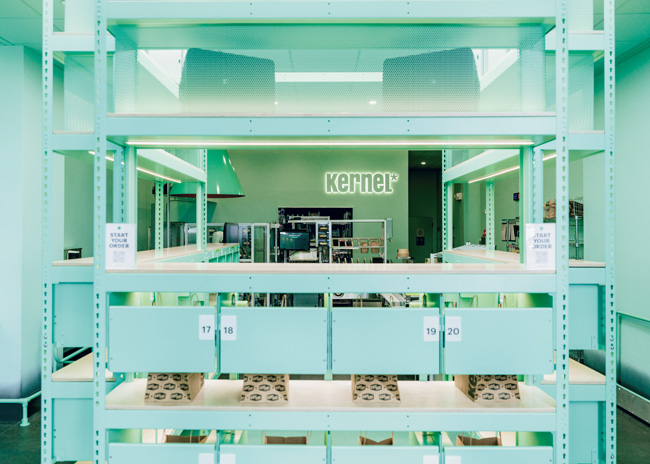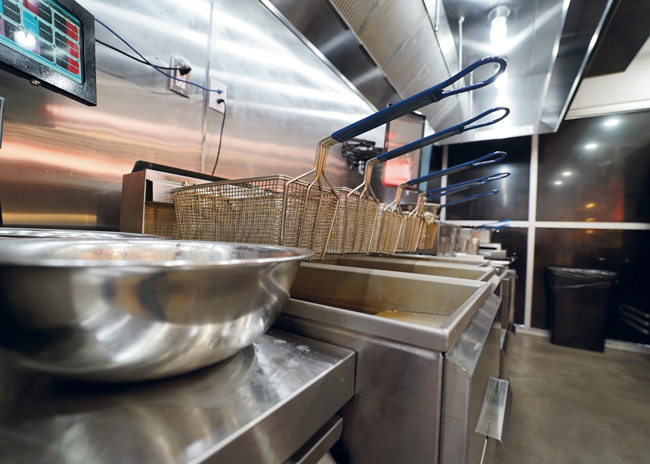A tale of revolutionary advancements, reality checks and the hunt for ROI.
 Little Caesars is holding off on some forms of automation but embracing those that help improve quality, service and convenience in ways that deliver ROI for franchisees. The chain’s temperature-controlled Pizza Portal mobile-order pickup stations fit that bill. Photo courtesy of Little CaesarsWhat’s the future of automation in the foodservice industry? Opinions vary and progress can be highly segment-specific — even concept-specific — but there’s little question that restaurant operations of tomorrow will be significantly more automated than they are today. Economics demand it. Advancing technologies enable it. And industry trailblazers are paving paths for others to follow. It’s early, however, and time will tell how dramatically automation advancements and first-to-market innovators will change the game for good.
Little Caesars is holding off on some forms of automation but embracing those that help improve quality, service and convenience in ways that deliver ROI for franchisees. The chain’s temperature-controlled Pizza Portal mobile-order pickup stations fit that bill. Photo courtesy of Little CaesarsWhat’s the future of automation in the foodservice industry? Opinions vary and progress can be highly segment-specific — even concept-specific — but there’s little question that restaurant operations of tomorrow will be significantly more automated than they are today. Economics demand it. Advancing technologies enable it. And industry trailblazers are paving paths for others to follow. It’s early, however, and time will tell how dramatically automation advancements and first-to-market innovators will change the game for good.
Consider Sweetgreen, which last year debuted its automated, front-of-the-house salad makeline, dubbed Infinite Kitchen. Hailed by Time magazine as “one of the best inventions of 2023,” the system robotically assembles salads and bowls, dispensing ingredients that have been prepped by human staff members through temperature-controlled chutes into bowls that move via conveyor belt below. Orders are placed and customized digitally, and team members work the front of the house to assist and provide hospitality as the automated system can fill bowls to order at a rate of up to 500 per hour, 50% faster than human employees could, according to the company.
Two Infinite Kitchen units have opened so far, one in Illinois and one in California, and the company reports that 7 of the approximately 25 new units it expects to open this year will likely feature the new automated model. Plans also include renovating three to four large urban units with the Infinite Kitchen.
In Sweetgreen’s fourth quarter 2023 earnings report, CEO Jonathan Neman cited benefits from the system including “higher throughput, better order accuracy, portioning consistency and substantially lower team member turnover. In addition to these benefits, we’ve also seen the average ticket at both locations more than 10% higher than their respective markets,” Neman said. The company notes each Infinite Kitchen costs between $450,000 and $550,000, and it expects the model to generate at least 7 points of margin improvement along with other benefits cited.
Or consider Kernel, a new concept from Steve Ells, who nearly 30 years ago brought Chipotle Mexican Grill to market. Opened in February of this year, the first Kernel unit operates from an 800-square-foot space in New York City. It’s a limited-menu restaurant designed to introduce a new quick-service operating model, one that’s smaller, more environmentally friendly, entirely plant-based and able to run at full throttle with an average of three employees per shift thanks to kitchen automation. Kernel plans to open at least 10 more units over the next two years.
The kitchen’s workhorse? A robotic arm that loads food into a custom conveyorized induction oven for finishing products to order. No prep occurs in the restaurant. Rather, human chefs and cooks at Kernel’s nearby central kitchen prep the ingredients and deliver the items hourly for on-site finishing and packaging as digital orders flow in. All orders are placed online. Guests receive an exact time to pick up their food (accurate to the minute, according to the company) and receive a text or email when it’s ready. Customers retrieve their orders via mobile phone app, which enables them to unlock a secure, designated cubby. The company says most guests are in and out in less than a minute.
With in-store food preparation largely automated and significantly fewer employees needed, Kernel also seeks to flip the script on traditional fast-food jobs. The brand’s employees receive compensation greater than industry norms (reportedly $25 to start), comprehensive benefits, flexible schedules, a stock option plan and ongoing educational opportunities.
 Kernel is a new highly automated, tech-forward concept by Chipotle founder Steve Ells. Photos courtesy of Benedict EvansAs a new and novel concept, Kernel is built from the ground up with customized automation and robotics in its DNA, as is Sweetgreen’s Infinite Kitchen and a handful of others. But automation is a topic of careful study and strategic investment across a wide swath of the industry, as both new and legacy brands seek ways to automate everything from taking orders, marketing and managing inventory, to frying fries, saucing pizzas, filling bowls and clearing dishes.
Kernel is a new highly automated, tech-forward concept by Chipotle founder Steve Ells. Photos courtesy of Benedict EvansAs a new and novel concept, Kernel is built from the ground up with customized automation and robotics in its DNA, as is Sweetgreen’s Infinite Kitchen and a handful of others. But automation is a topic of careful study and strategic investment across a wide swath of the industry, as both new and legacy brands seek ways to automate everything from taking orders, marketing and managing inventory, to frying fries, saucing pizzas, filling bowls and clearing dishes.
The big drivers? Labor costs, speed of service, efficiency and consistency — all of which automated solutions can enhance. Front-of-the-house shifts have already been seismic in many industry segments, with digital, self-service order capabilities now common and AI-assisted customer service and marketing technologies gaining traction. And, while overt automation (in the form of robotics and autonomous delivery) remains the outlier, programmable equipment and connected kitchens have for years supplemented human labor in the back of the house, partially automating kitchen operations and impacting those big drivers.
Dan Bendall, principal at FoodStrategy Inc., a Potomac, Md.-based consulting firm, says while full-scale automation in foodservice kitchens is still in its infancy, practical, game-changing advancements have been made. “It may not be as jazzy as robotics — we still have a long way to go with that — but there are a lot of automated technologies already in play that make life easier for operators and employees,” Bendall says. “Programmable equipment, for instance, is a first step toward automation. It takes the complexity out of preparing a recipe, enabling the operator to use less, and less skilled, labor. Rather than a trained chef, they now need someone who can take the chicken out of the refrigerator, put it in a pan and press a button to produce a high-quality, consistent product.”
Bendall points also to automated data-reporting technologies as practical applications being embraced by more operators. “We’re seeing a lot of interest in these systems,” he says. “They make it easy for a manager in one central location to monitor time and temperature data coming in from multiple pieces of equipment in multiple locations, for example. It’s a very effective form of automation, helping operators to quickly identify problems and manage more efficiently.”
As for the “jazzy” robotics, Bendall sees some progress and experimentation happening, primarily on the chain side of the industry, with a few large operators leading the way. “It’s still very limited, but the robotics-style automation that’s out there is only going to get better and more varied,” he predicts. “Ultimately, it will move into other markets and, just as digital ordering technologies have, will become widely accepted, especially with labor costs continuing to rise.”
Juan Martinez, founder and principal at industrial engineering consultancy Profitality Labor Guru, agrees labor will be the key driver in securing a wider embrace of automation. “People in the industry, especially the QSR segment, have been talking about automation forever. And a lot of cooking functions are already much more automated than they used to be. But the payback for fully automated solutions in many cases just hasn’t been there. Labor was always available and affordable,” Martinez notes. “Today, that’s no longer the case. Employees are hard to find, and labor isn’t cheap. Look at California’s new $20-per-hour minimum for fast-food workers, which is helping create fertile ground for more automation. There’s much more conversation, innovation and experimentation happening. The technologies exist, but the big question is how do you commercialize them, bring them to fruition in hostile environments like restaurant kitchens and drive-thru lanes?”
 Designed to introduce a smaller, hyperefficient operating model, Kernel’s kitchen features a robotic arm that loads food into a conveyorized induction oven for finishing to order.
Designed to introduce a smaller, hyperefficient operating model, Kernel’s kitchen features a robotic arm that loads food into a conveyorized induction oven for finishing to order.
Many Watch and Wait
Automated technologies, attractive as they may be in theory, also don’t come with small price tags, keeping many of them squarely in pipe-dream category for mainstream restaurant operators. And attempting to fit new automated technologies into existing kitchens where they need to function efficiently alongside human employees — in spaces designed with humans in mind — can be expensive and complicated. As such, when it comes to back-of-the-house solutions, many operators are in watch-and-wait mode, preferring to invest instead in lower-risk, higher-return technologies.
One such company is Craveworthy Brands, a fast-growing multiconcept operator that, to date, has acquired or developed 10 brands, mostly in the fast-casual segment. That’s true at least when it comes to robotics replacing humans trained in the art of cooking, according to Gregg Majewski, Craveworthy’s founder and CEO. Citing myriad variables that need to come together to consistently produce high-quality food — variables he has yet to see a robot master — Majewski nonetheless sees great promise in other forms of operational automation, especially for simplifying and supporting managerial functions.
“If you’re running the same item over and over — fries, for example — you can get a robot to drop them. But it’s very, very hard to have the art of cooking done by a robot,” Majewski says. “No piece of meat or fish or even french fry cooks the same every time. There are too many variables that require skill, instinct and flexibility in the kitchen. To me, the bigger potential for automation and AI is in helping managers reduce or eliminate paperwork and simplify things like projections, inventory management and scheduling. There, it can be a huge time saver and cost reducer, because waste and training are so expensive. With the skill set in the labor market for restaurant jobs as it is, we have to automate a lot more of the things that are harder to teach and train for.”
According to the National Restaurant Association’s 2024 Restaurant Technology Landscape report, these are, indeed, the types of behind-the-scenes, non-customer-facing automation investments that many more operators, full- and limited-service alike, are making today. For example, 52% of all operators in the study said they plan to devote resources this year to systems that automate functions including payroll, finance, tax and food safety compliance, and inventory control/management. And 37% plan to invest in labor management systems that automate recruitment and scheduling.
In contrast, planned investment this year in other, still-emerging automation initiatives is significantly lower, according to the report. For example, 26% of operators said they plan to invest in AI integration, including voice recognition. And there’s an even smaller appetite for investing in robotics (5%) and drones/autonomous vehicle delivery (3%), suggesting there’s still a long way to go before such technologies gain traction.
Las Vegas-based Wing Zone, with 30 North American units, is enthusiastic about implementing kitchen robotics, and in 2022 the company announced aggressive plans to roll out such systems across its portfolio. But, while testing continues, the brand has since slowed its drive to incorporate kitchen robotics, according to David Bloom, CEO of Wing Zone and Capriotti’s Sandwich Shop, which acquired the wing concept in 2020.
Bloom notes that, while progress is being made toward making robotics more efficient, dependable and scalable, no such systems are ready for prime time yet. “No brands are all-in on robotics. They’re just not scalable yet,” he notes, adding that, while increasing labor costs add a sense of urgency, current marketplace realities contribute to slowing development and adoption. “Interest rates are high, and there’s been a reduction in investment in some of the more speculative types of projects, such as robotics and autonomous delivery,” Bloom says. “Investment groups and private-equity firms have tightened up their risk tolerance. We’ve also seen large, global restaurant brands acquiring or forming exclusive partnerships with leading-edge tech companies, which keeps some of those solutions in limited distribution.”
Nonetheless, Wing Zone continues to test robotics while also grappling with the inherent operational challenges that some of the new technologies present. “We continue to learn, and the robotics companies themselves are still learning,” Bloom says. “One big challenge, for example, is new build versus retrofit situations. There’s a huge difference between the two, because you can custom-design a new restaurant to maximize safety and efficiency, whether you’re doing a rail-mounted robotic system or an actual robot that’s mobile. But in an existing restaurant, you might have your grill over here, fryers over there and the food has to go out over here. That requires a very different and flexible system. You don’t want three robots doing the work that one person can realistically do.”
 While Wing Zone’s back-of-the-house lineup at the moment does not specify high-end robotics equipment in existing units, the chain continues to test and learn from robotics applications. Photo courtesy of Wing Zone
While Wing Zone’s back-of-the-house lineup at the moment does not specify high-end robotics equipment in existing units, the chain continues to test and learn from robotics applications. Photo courtesy of Wing Zone
ROI Matters
Even when automated kitchen solutions do seem viable, rolling them out across franchised organizations becomes no small task. Moving too quickly and issuing new operational standards incorporating robotics or other forms of automation without a clear focus on ROI would not sit well with franchisees, notes Edward Gleich, president of Little Caesars Global Services. Beyond digital solutions for ordering, paying and managing loyalty programs, the pizza chain takes a relatively conservative approach to automation on the food prep and delivery side. Gleich says that while some stores have implemented features such as automated pizza saucers, the brand always looks for new ways to improve quality, service and convenience. To that end, it unveiled a temperature-controlled Pizza Portal mobile-order pickup station in all U.S. units. But make no mistake: Little Caesars is not interested in innovation for innovation’s sake.
“There are things we’re taking a wait-and-see approach on to make sure they’re right for us and for our franchisees,” Gleich says. “Franchisees are very smart, and as the franchisor we really need to do our homework and understand what their appetite is for these types of new investments. They understand pretty quickly what’s in it for them in terms of cost versus benefit. If they see immediate value, they’ll usually get behind it. But where they question the value and the expense, those things are much harder to roll out. The economics have to work for them.”
The simple state of existing restaurant kitchens can also be a big hurdle to clear the path toward greater kitchen automation. Unlike in industries in which robotics can work seamlessly, thanks to consistency and uniformity, there’s much that can go awry in restaurant kitchens.
“When it comes to robotics, anything that involves moving food around is complicated,” notes Foster Frable, principal at CFL Design, a foodservice consultancy in White Plains, N.Y., and long-time judge of the National Restaurant Association Show’s Kitchen Innovations Awards program. “Food isn’t generally uniform, and there are more chances of having to deal with clogs and errors with robotics. That one big cherry tomato in the dispensing chute can jam up the system, and the operator can spend a lot of time and effort on keeping it unjammed versus reaping the rewards of the automation. And when you add in the minimal effort put forth in a typical kitchen toward maintenance — much less, preventive maintenance — on equipment, it’s a recipe for serious problems. Suddenly, you’re having to pay a $50-an-hour engineer to solve an equipment or tech problem that would never have occurred with a $20-an-hour employee doing the job manually.”
Profitality’s Martinez says it’s these types of calculations that have to go into any decision to implement new automated kitchen solutions. “No restaurant operation is a charity. At the end of the day, there has to be a payback,” he says. “Any time you consider automation or robotics, you need to carefully consider it from the standpoint of speed of service, throughput, safety, accuracy, space utilization and especially labor. What is it going to actually do for you? Quantify what the expectations are to really understand where the payback will be. Maybe it’s in sales, or throughput or labor, but you’ve got to have clear, quantifiable payback or you’re wasting your money and possibly putting your brand at risk.”
Consumer Sentiment: Lukewarm on Robotics/Automation
How do consumers feel about the march of automation and robotics into restaurant operations? For systems proven to make ordering and paying easier, faster, more efficient and more accurate, the majority give two thumbs up, according to National Restaurant Association research. For food preparation and delivery? We’re not there yet. Much depends on age group, with younger consumers more open to emerging, tech-driven operating models, but overall sentiment — at least for now — remains lukewarm.
- 29% of all adults would order full-service restaurant (FSR) food prepared by automated systems or robots
- 37% would order FSR food delivered by automated systems or robots
- 36% would order food delivered from limited-service restaurants (LSRs) by automated systems or robots
- 33% would order food from LSRs by talking to an AI-generated person on a video screen
- 30% would order food from LSRs prepared by automated systems or robots
- 62% would choose an LSR that offers traditional, employee-based service over a comparable LSR that incorporates technology into the experience
Source: NRA Restaurant Technology Landscape Report 2024
A Noncommercial Perspective
 Steve Giardini, Senior Director, University of Michigan (UMich) DiningSteve Giardini, Senior Director, University of Michigan (UMich) Dining
Steve Giardini, Senior Director, University of Michigan (UMich) DiningSteve Giardini, Senior Director, University of Michigan (UMich) Dining
Q: Has automation found footing in large college and university dining operations like yours?
A: So far, most of what we’ve seen in the automation realm isn’t built for our scale. We have 31 different operations, including 9 dining halls and 18 retail operations, as well as 4 catering kitchens and a bakeshop. We’re testing a few things, but we don’t have much automation yet. We’re trying to get the word out to different vendors and manufacturers that we need solutions that are bigger and faster. It’s come a long way and gets better every day, but we continue to look for the equipment industry to catch up on automating things at scale.
Q: What have you been testing?
A: We’ve been testing a made-to-order pizza station in our largest dining hall for about a year. It’s been fairly successful. It offsets labor to the equivalent of about one full-time employee a week, and it’s one of the few pieces of automated equipment we’ve seen that can do volume — from 80 to 100 pizzas an hour. There are some things we don’t like about it, and it’s hard to shoehorn it into an existing facility that wasn’t designed for it, but in addition to saving labor, we’ve seen a reduction in food cost due to consistency of sauce and cheese application.
Q: What other solutions are on your automation wish list?
A: For me and a lot of my colleagues in college and university dining, our biggest wish is for automated dish rooms. Those are notoriously hard jobs to fill. We need to think about real solutions, and it comes down to how we work with manufacturers to design, rework and test equipment that can help us automate some of those less-desirable jobs.
Q: Will new UMich Dining facilities have more automation designed in from the start?
A: Yes. As with the pizza station, trying to put new automated equipment into existing facilities can be like putting a square peg into a round hole, and ROI is much harder to achieve. But it’s also a challenge because the technology changes so fast. When we plan a new hall it’s a three- or four-year process, so it’s tough to design placeholders for what might be available and what infrastructure might be needed by the time we open. We rely on consultants and vendor reps to keep us educated on what’s in the pipeline.
Q: Looking ahead, where do you expect to see the greatest adoption of automated solutions?
A: Definitely on the software side, helping automate tasks like menu planning, procurement and inventory management. We’re excited about where that piece is headed. There’s still a long way to go on the equipment side, but I think we’ll get there. I just hope it’s sooner rather than later.



